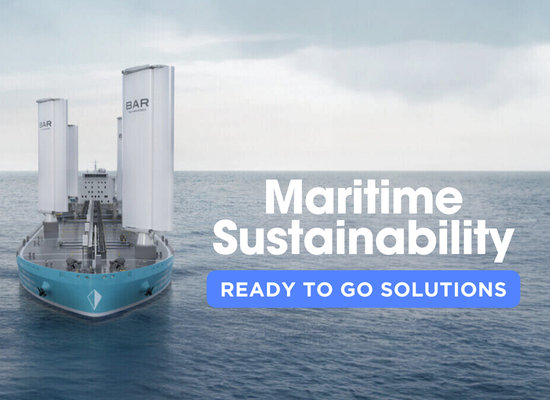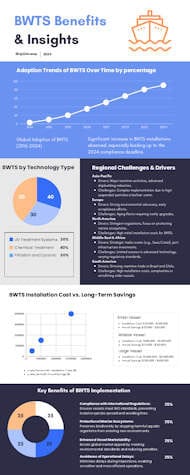Revolutionizing Maritime Sustainability: Five Ready-to-Go, Game-Changing Innovations

As the global demand for shipping continues to grow, the maritime industry faces mounting pressure to adopt sustainable practices that minimize environmental impact. From reducing greenhouse gas emissions to preventing the spread of invasive species, innovative technologies are paving the way for a greener future on the high seas. This article explores five revolutionary developments that are transforming maritime sustainability, showcasing how cutting-edge solutions like air lubrication systems, wind-powered ships, alternative fuels, ballast water treatment, and autonomous vessels are setting new standards for eco-friendly shipping. Join us as we delve into these groundbreaking advancements and their profound impact on the maritime world.
#1 Air Lubrication Technology
Overview
Air lubrication technology is a transformative innovation in the maritime industry, designed to enhance fuel efficiency and reduce environmental impact. By creating a layer of air bubbles along the ship’s hull, this technology minimizes friction between the hull and the water, resulting in substantial fuel savings and a significant reduction in greenhouse gas emissions.
How It Works
Air Bubble Generation
The core of air lubrication technology lies in the generation of air bubbles. Specialized equipment installed on the ship’s hull generates a continuous stream of air bubbles. This equipment typically consists of air compressors and bubble release units strategically placed along the bottom of the vessel.
Layer Formation
Once the air bubbles are released, they form a thin, consistent layer between the hull and the water. This layer acts as a cushion, significantly reducing the frictional resistance that a ship encounters as it moves through water.
Efficiency Improvement
The reduction in drag achieved through air lubrication means that the ship requires less energy to maintain its speed. Consequently, the amount of fuel needed is reduced, leading to lower operational costs and a decrease in carbon dioxide emissions. Studies have shown that air lubrication can reduce fuel consumption by up to 10%, making it a highly effective measure for enhancing maritime sustainability.
Benefits
Fuel Savings
One of the most immediate benefits of air lubrication technology is the reduction in fuel consumption. By decreasing the frictional resistance, ships can operate more efficiently, leading to significant fuel savings over time. This is particularly important given the high costs of marine fuel.
Emission Reduction
Air lubrication also plays a crucial role in reducing the environmental footprint of maritime operations. Lower fuel consumption directly translates to reduced emissions of carbon dioxide and other greenhouse gases, helping to combat climate change and comply with increasingly stringent environmental regulations.
Cost Efficiency
While the initial investment in air lubrication systems can be substantial, the long-term savings on fuel and maintenance costs often outweigh the upfront expenses. Moreover, ships equipped with this technology may also benefit from lower insurance premiums due to reduced operational risks.
Real-World Applications
Several major shipping companies have already begun to implement air lubrication technology across their fleets. For instance, Mitsui O.S.K. Lines (MOL) has reported successful trials of air lubrication on its vessels, achieving notable fuel savings and emission reductions. Similarly, Silverstream Technologies has partnered with various shipowners to retrofit their vessels with air lubrication systems, showcasing the technology’s adaptability and effectiveness.
Challenges and Future Prospects
Technical Challenges
Despite its benefits, air lubrication technology faces several challenges, including the complexity of retrofitting existing vessels and ensuring the durability of the systems in harsh marine environments. However, ongoing research and development are focused on overcoming these hurdles and enhancing the reliability and efficiency of the technology.
Future Developments
The future of air lubrication technology looks promising, with continuous advancements aimed at optimizing bubble generation and distribution. As the technology matures, it is expected to become a standard feature in new ship designs and retrofitting projects, playing a pivotal role in the global push towards maritime sustainability.
#2 The Use of Wind to Power Ships
Overview
Harnessing wind power is an ancient practice in maritime history, but recent technological advancements have enabled its resurgence as a viable and sustainable energy source for modern ships. Companies like BAR Technologies are at the forefront of this innovation, developing sophisticated wind propulsion systems that significantly reduce fuel consumption and emissions.
How It Works
Modern Wind Propulsion Systems
Modern wind propulsion systems utilize various technologies to harness wind energy effectively. These systems include rigid sails, rotors, and kites, each designed to optimize the use of wind power to propel ships.
- Rigid Sails: These are solid, aerodynamic structures that capture wind energy and convert it into thrust. Unlike traditional sails, rigid sails are more efficient and easier to manage.
- Rotors: Rotor sails, also known as Flettner rotors, use the Magnus effect to generate lift and propel the ship. These cylindrical rotors spin to create differential pressure, resulting in forward thrust.
- Kites: Large kites deployed from the bow of a ship can capture high-altitude winds, providing an additional source of propulsion.
BAR Technologies’ Role
BAR Technologies, a leader in maritime innovation, has developed the WindWings solution. This system utilizes large, rigid sails that can be retrofitted onto existing vessels or integrated into new ship designs. WindWings are designed to optimize aerodynamic efficiency, harnessing wind power to reduce fuel consumption and emissions.
Benefits
Fuel Savings
By integrating wind propulsion systems like those developed by BAR Technologies, ships can achieve substantial fuel savings. Wind power reduces the reliance on traditional fossil fuels, cutting down on operational costs and enhancing the ship’s overall efficiency.
Emission Reduction
The use of wind as a supplementary power source significantly lowers greenhouse gas emissions. Ships equipped with BAR Technologies’ WindWings can reduce their carbon footprint, contributing to global efforts to combat climate change and meet stringent environmental regulations.
Operational Flexibility
Wind propulsion systems offer additional operational flexibility. For example, BAR Technologies’ WindWings can be adjusted or retracted depending on wind conditions and navigational requirements, ensuring that ships can optimize their routes and speeds effectively.
Real-World Applications
Case Studies
BAR Technologies has partnered with several shipping companies to deploy its WindWings solution. One notable project involves the retrofitting of large cargo vessels with WindWings, resulting in fuel savings of up to 30% under optimal wind conditions. This collaboration demonstrates the practical benefits and scalability of wind propulsion systems in real-world maritime operations.
Challenges and Future Prospects
Technical Challenges
While wind propulsion systems offer numerous benefits, they also present certain challenges. These include the need for significant initial investment, the complexity of retrofitting existing ships, and the variability of wind conditions. However, continuous advancements by companies like BAR Technologies are addressing these issues, making wind propulsion increasingly viable.
Future Developments
The future of wind propulsion in the maritime industry looks promising. Innovations from BAR Technologies and other leaders in the field are expected to further enhance the efficiency and reliability of wind propulsion systems. As the industry moves towards greater sustainability, wind power is set to play a crucial role in reducing the environmental impact of shipping.
#3 Alternative Fuels and Hybrid Systems
Overview
The maritime industry is increasingly turning to alternative fuels and hybrid systems to reduce its environmental footprint. These innovations promise to significantly cut greenhouse gas emissions and pollutants while improving fuel efficiency. Notable alternative fuels include liquefied natural gas (LNG), biofuels, and hydrogen, while hybrid systems integrate traditional engines with renewable energy sources like batteries and fuel cells.
How It Works
Alternative Fuels
- Liquefied Natural Gas (LNG): LNG is a cleaner-burning fossil fuel that reduces carbon dioxide emissions by about 20% compared to traditional marine fuels. It also cuts sulfur oxide and nitrogen oxide emissions, making it a more environmentally friendly option.
- Biofuels: Derived from renewable biological sources such as vegetable oils and animal fats, biofuels can be used in existing engines with minimal modifications. They offer a significant reduction in carbon emissions and are biodegradable, reducing the risk of environmental damage from spills.
- Hydrogen: Hydrogen fuel cells produce electricity through a chemical reaction between hydrogen and oxygen, emitting only water vapor as a byproduct. This technology is still in its early stages for maritime use but holds great promise for zero-emission shipping.
Hybrid Systems
- Battery-Electric Systems: These systems use batteries to store energy that can power the ship’s propulsion and auxiliary systems. Batteries can be recharged using shore power or renewable sources like solar panels and wind turbines.
- Fuel Cell Systems: Fuel cells convert chemical energy from fuels like hydrogen into electricity through an electrochemical reaction. They offer a high-efficiency, low-emission alternative to traditional combustion engines.
- Combination Systems: Hybrid systems often combine different technologies to optimize performance and reduce emissions. For example, a ship might use LNG engines for long-distance travel and battery-electric power for maneuvering in port.
Benefits
Emission Reduction
Alternative fuels and hybrid systems significantly reduce harmful emissions. LNG, for example, cuts carbon dioxide emissions by 20%, while hydrogen fuel cells produce zero emissions. This helps the maritime industry comply with stringent environmental regulations and contributes to global efforts to combat climate change.
Improved Fuel Efficiency
Hybrid systems improve fuel efficiency by optimizing the use of different energy sources. For instance, using batteries for short operations and traditional fuels for longer journeys can reduce overall fuel consumption. This translates to lower operational costs and a smaller carbon footprint.
Energy Diversification
By adopting alternative fuels and hybrid systems, the maritime industry diversifies its energy sources, reducing dependence on traditional fossil fuels. This not only enhances energy security but also fosters innovation in renewable energy technologies.
Challenges and Future Prospects
Technical Challenges
The adoption of alternative fuels and hybrid systems faces several challenges, including the need for new infrastructure, higher initial costs, and the availability of fuel sources. For example, LNG requires specialized storage and handling facilities, while hydrogen production and distribution are still in their infancy.
Future Developments
The future of alternative fuels and hybrid systems in the maritime industry is promising, with ongoing research and development aimed at overcoming current limitations. Advances in fuel cell technology, improvements in battery storage, and the development of sustainable biofuels are expected to drive further adoption. As regulatory pressures and environmental awareness increase, the shift towards these sustainable solutions will likely accelerate.
#4 Ballast Water Treatment Systems
Check it out
This ShipUniverse infographic dives into the essential benefits of Ballast Water Treatment Systems. From compliance to ecosystem protection, see how BWTS is transforming maritime operations for the better!
Overview
Ballast water treatment systems (BWTS) are critical for preventing the spread of invasive aquatic species through the discharge of ballast water from ships. These systems treat ballast water to meet international standards, ensuring that harmful organisms are not transported across different marine environments. The implementation of BWTS is a key aspect of maritime sustainability, addressing both environmental protection and regulatory compliance.
How It Works
Ballast Water Intake
When a ship takes on ballast water, it typically draws in large volumes of water along with any organisms living in that water. These organisms can include bacteria, plankton, and small fish.
Treatment Processes
Ballast water treatment systems employ various processes to eliminate or neutralize these organisms before the water is discharged. The primary treatment methods include:
- Mechanical Filtration: This process involves physical removal of larger particles and organisms through filtration systems.
- Chemical Disinfection: Chemical agents, such as chlorine or ozone, are added to the ballast water to kill or neutralize harmful organisms.
- UV Radiation: Ultraviolet (UV) light is used to disinfect ballast water by damaging the DNA of microorganisms, rendering them incapable of reproducing.
- Deoxygenation: This method removes oxygen from the ballast water, creating an environment where aerobic organisms cannot survive.
Ballast Water Discharge
After treatment, the ballast water can be safely discharged into the marine environment, meeting international standards set by organizations such as the International Maritime Organization (IMO).
Benefits
Environmental Protection
BWTS play a crucial role in protecting marine ecosystems by preventing the spread of invasive species. Invasive species can disrupt local ecosystems, outcompete native species, and cause significant environmental and economic damage.
Regulatory Compliance
International regulations, such as the IMO’s Ballast Water Management Convention, require ships to manage their ballast water to prevent the transfer of invasive species. Implementing BWTS ensures compliance with these regulations, avoiding penalties and port entry restrictions.
Operational Efficiency
Modern BWTS are designed to integrate seamlessly with a ship’s operations, minimizing downtime and ensuring that ballast water management does not interfere with the vessel’s schedule. This efficiency is vital for maintaining the economic viability of maritime operations.
Challenges and Future Prospects
Technical Challenges
The installation and maintenance of ballast water treatment systems can be complex and costly. Retrofitting existing vessels with BWTS requires careful planning and significant investment. Additionally, ensuring the consistent performance of these systems under varying water conditions poses technical challenges.
Future Developments
The future of BWTS looks promising, with ongoing research focused on enhancing the efficiency and reliability of these systems. Advances in treatment technologies, such as more effective chemical agents and improved UV systems, are expected to drive further adoption. As regulations become stricter and environmental awareness grows, the demand for innovative and robust ballast water treatment solutions will increase.
#5 Advanced Hull Coatings
Overview
Advanced hull coatings are a significant development in maritime sustainability, designed to reduce fuel consumption and minimize environmental impact. These coatings improve a ship’s hydrodynamic efficiency by reducing friction between the hull and the water, preventing biofouling, and extending maintenance intervals.
How It Works
Hydrodynamic Efficiency
Advanced hull coatings are formulated to create a smooth surface on the ship’s hull, which reduces drag as the vessel moves through the water. By minimizing resistance, these coatings help improve fuel efficiency and reduce emissions.
- Silicone-based Coatings: These coatings provide a slick surface that minimizes friction, enhancing the vessel’s speed and fuel efficiency.
- Non-toxic Biocide Coatings: These coatings prevent the growth of marine organisms on the hull without releasing harmful substances into the environment.
Anti-fouling Properties
Biofouling, the accumulation of marine organisms on the hull, increases drag and reduces fuel efficiency. Advanced hull coatings incorporate anti-fouling technologies to prevent these organisms from adhering to the hull.
- Foul-release Coatings: These coatings create a surface that marine organisms cannot easily attach to, reducing biofouling.
- Biocide-free Solutions: Newer technologies are focusing on biocide-free coatings that are environmentally friendly and prevent the growth of marine life on the hull.
Benefits
Fuel Savings
By reducing drag and preventing biofouling, advanced hull coatings contribute to significant fuel savings. Ships can maintain higher speeds with lower fuel consumption, leading to reduced operational costs and lower greenhouse gas emissions.
Reduced Maintenance
These coatings extend the intervals between necessary hull cleanings and maintenance. Ships can operate for longer periods without the need for dry-docking, reducing maintenance costs and increasing operational efficiency.
Environmental Protection
Advanced hull coatings help protect marine ecosystems by preventing the spread of invasive species through biofouling. Additionally, the use of non-toxic, biocide-free coatings ensures that harmful chemicals are not released into the ocean, further safeguarding marine life.
Challenges and Future Prospects
Technical Challenges
The development and application of advanced hull coatings involve technical challenges, including ensuring their durability and effectiveness over long periods and under varying marine conditions. Continuous research is required to improve the formulations and application processes of these coatings.
Future Developments
The future of advanced hull coatings looks promising, with ongoing innovations aimed at enhancing their anti-fouling properties and hydrodynamic efficiency. Researchers are exploring new materials and technologies, such as nano-coatings and environmentally friendly biocide alternatives, to further improve performance and sustainability.

Do you have a Maritime Product or Service that may be of interest to Shipowners? Tell us about it here!
Do you have feedback or insights? Please reach out to editor @ shipuniverse.com




